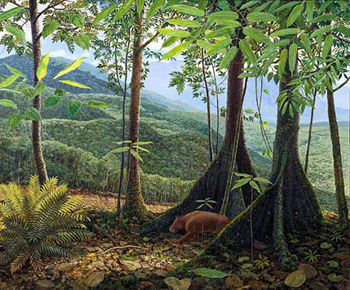|
The Flatirons Outdoor Classroom is a K-12 curricular project involving the Boulder Valley School District, the Denver Museum of Nature and Science, and the University of Colorado. The Project consists of an interdisciplinary outdoor learning environment that combines elements of science, art, social studies, and the humanities, and a forthcoming suite of curricular materials designed to make effective use of the classroom.
The classroom itself consists of four elements. A riverbed runs the length of the
school building (135 feet), offering a depiction of the Boulder Creek watershed. At the
top, students are able to fill a 600 gallon reservoir with water, and then send a flood down
the channel. Streamflows are used for experiments in hydrology and sedimentology, as
well as for thought experiments in water politics (e.g., learning about senior/junior water
rights and the possible effects of 100 year floods along Boulder Creek). The water is
captured in a large underground cistern, and pumped back up to the reservoir for repeated experiments.
Second, a geology exhibit uses samples of local strata to represent the Flatirons and other regional features of the Rocky Mountains and High Plains. Adjacent
to the rocks, on the side of the building, a large mural is being created that depicts
Colorado across geologic history. Utilizing reproductions of paintings commissioned by
the Denver Museum of Nature and Science--a partner on the project--teachers will be
able to move back and forth between the representations of ancient Denver and the rock
outcrops, instructing students in the philosophical and political aspects of scientific
research by juxtaposing the geologic strata to pictures of the geologic past.
Third, a performing arts area sits adjacent to the geology exhibit, consisting of a
stage and a terraced seating area, with the streambed running between. A small Zen
garden also rests between the geology exhibits and the stage, providing opportunities for
artistic expression and personal development. Finally, on the eastern end of the project a
botanical garden has been created: in addition to various types of garden plants, the space will be used for cultivating plants used by Western pioneers. Students in each grade level will have direct curricular ties to the classroom: studying water, rock, and the soil; planting seeds, bulbs and vegetable crops; and watching and learning about insects and birds. Teachers will use each of these areas as teaching tools to explore the connections between scientific investigations and artistic expression.
Phase 2 plans—just launched—call for the dissemination of the curricular ideas
generated by the outdoor classroom. After a series of in-services where district teachers
will receive training in integrating the earth sciences and the humanities within the
classroom space, regional workshops will be run at the outdoor classroom, where
educators can use this site as the model for research and discussion of interdisciplinary
approaches to K-12 education. The goal is to create a model that will help schools
nationwide apply the principles learned here for developing interdisciplinary outdoor
classrooms in their own localities nationwide. |
 64 million years ago (early Paleocene)
64 million years ago (early Paleocene)